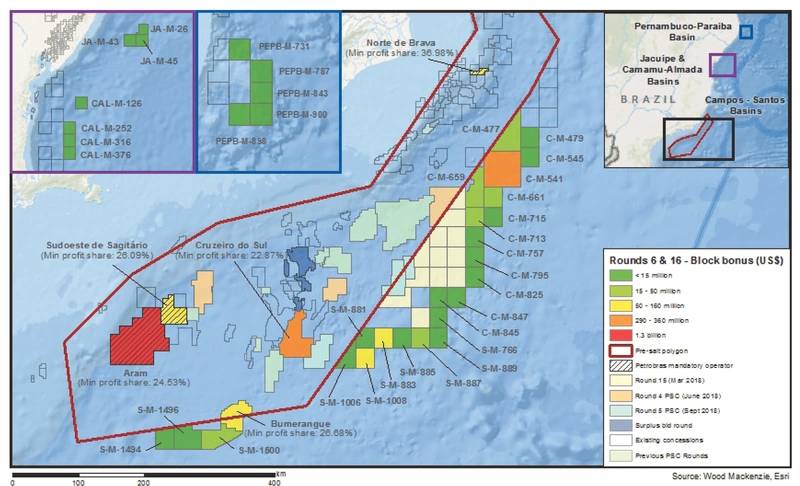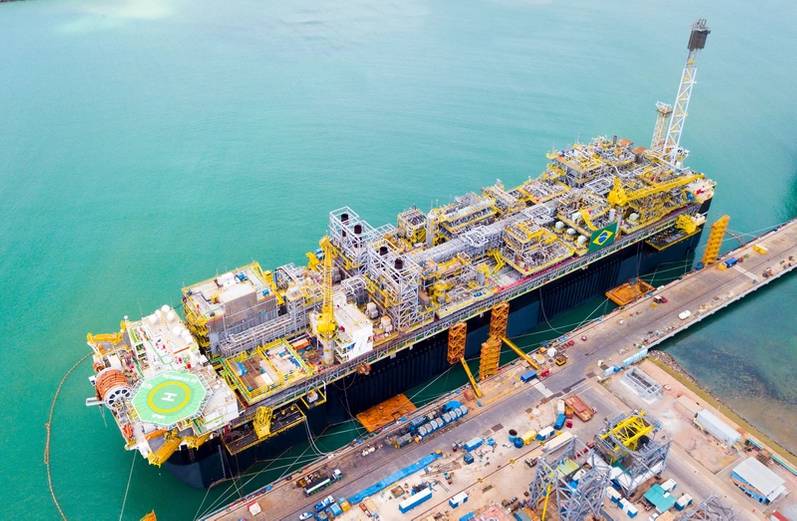
Brazil’s offshore oil and gas sector: it’s complicated, challenging and rife with opportunity.
Brazil today is seeing offshore activity increase, production is on the rise, and its government has made significant strides to remove obstacles for investment. But not long ago the picture looked very different for one of the planet’s foremost offshore oil and gas regions.
Brazil, just like the rest of the world, was hit hard by the oil price downturn, but the slump’s effects were amplified in the South American country by the so-called Operation Car Wash corruption scandal which saw executives from Brazil’s state oil firm allegedly take bribes in return for awarding inflated contracts. On the back of the industry downturn and scandal, spending and activity offshore Brazil were reduced more than other regions, said Lars Lysdahl, a principal analyst at Rystad Energy. “An example is the demand for floater rigs, which has declined by almost 80% since the 2013 peak, while other comparable regions like US Gulf of Mexico and West Africa are down by 30-50% in the same time period,” he said.
But these days, following impactful policy shifts, and with a number of large high-impact fields slated to come on stream and ready for development, things are looking up long term for the country and its largest exploration and production company, Brazilian state-run oil firm Petroleo Brasileiro SA, or Petrobras, as the firm is commonly known.
“Now that Petrobras has pretty much gotten the corruption scandal under control, activity in Brazil should be brisk over the next decade or two,” said Jim McCaul, head of International Maritime Associates and World Energy Reports. “The country is also opening up to foreign investment. This will help draw more international players and augment Petrobras’ project start capabilities.”
Lysdahl, too, said he sees promise. “Brazil is one of the regions with the best potential for an activity boom going forward,” he said, but noted, “This boom has not started yet, we need to see more field sanctioning first, which is an early indicator of activity.”
Local regulatory changes have played an important role. In a rethink of the nation’s offshore strategy, the Brazilian government in 2016 instituted the Pedefor (Program for Stimulating the Competitiveness of the Supply Chain, the Development and the Improvement of Suppliers of the Oil and Natural Gas Sector) to relax local content rules and incorporate new financial incentives for foreign companies.
“On recent license rounds Petrobras is not mandated to be the operator, although they still have the first right of refusal. This opens up for other exploration and production companies, spurring their interest as they can influence field development and build local competence and organization as operators,” Lysdahl said.
Brazil’s recent pre-salt rounds have been competitive and attracted global majors, with foreigners such as BP, Equinor, ExxonMobil and Shell all now operators and expected to compete again in upcoming rounds, including the licensing bonanza soon to commence in the final quarter of this year.
On October 10, Concession Round 16 will offer 36 blocks in five basins, including three that are frontier. On November 7, PSC Round 6 will offer five blocks in the Campos and Santos basins. Half the acreage on offer is in the prolific Santos, where the Brazilian government is looking to cash in big, said Marcelo de Assis, Head of Latin America Upstream Research at Wood Mackenzie. “We expect fierce competition.”
A big prize, de Assis said, will be offered up during the transfer-of-rights (TOR) surplus round slated for November 6 (one day before PSC round 6).
The TOR areas encompass six high-quality pre-salt fields holding 15 billion boe, found between 2010 and 2013 and declared commercial in 2014. The government, which in 2010 assigned Petrobras 5 billion boe, will now auction rights to all resources beyond the original assigned volume in four of the areas (Atapu, Buzios, Itapu and Sepia), via production sharing contracts. According to Wood Mackenzie, recoverable reserves estimates for the surplus volume range from 6 billion to 15 billion boe.
The round is expected to attract a swathe of large global oil companies, including Petrobras, with 14 firms approved to take part. Government officials have said the auction could raise more than 100 billion reais ($26 billion).
 Most acreage on offer in Concession Round 16 and PSC Round 6 will be in the Campos ad Santos basins (Source: Wood Mackenzie/Esri)
Most acreage on offer in Concession Round 16 and PSC Round 6 will be in the Campos ad Santos basins (Source: Wood Mackenzie/Esri)
Production rising
Brazil’s monthly oil and natural gas production reached a record 3.828 million boe per day (boepd) in August 2019, regulator ANP reported.
The majority (63.4%) of production was from the pre-salt, where 110 wells produced 2.427 million boepd. Lula, in the Santos basin, produced the most oil, an average of 1.026 million boepd. It was also the largest producer of natural gas: an average of 43.4 million cubic meters per day.
“The size and productivity of the reservoirs in the Santos basin offshore Brazil are huge,” McCaul said. “Production achieved by floating production, storage and offloading units (FPSO) placed in operation in the Santos basin over the past decade has been astounding.”
The output leader in August, ANP said, was the FPSO Cidade de Maricá in Lula Field, producing 150,600 boepd through seven interconnected wells.
More large producers are on the way. In mid-September, the newbuild FPSO P-68 left the Sembcorp Marine’s Estaleiro Jurong Aracruz (EJA) shipyard in Brazl for deployment in the ultra-deepwater Berbigao and Sururu fields, adding up to 150,000 boepd production from the Santos basin. The same shipyard is also working on the P-71 FPSO, also destined for Santos.
“Santos output has been increasing ever since the first large fields started in 2010 and is now producing around 1.5 million boepd. With all the pre-salt developments and large projects such as Iara, Buzios and Mero, we expect a boom in new FPSO installations and production exceeding 3 million boepd by 2025,” Lysdahl said.
Some 32% of the world’s 219 planned FPSO projects are in Brazil, according to World Energy Report’s August 2019 update. There are five FPSOs on order for the Santos basin alone.
“The largest field development hub is Buzios, where two FPSOs started up last year, two more are coming online this year and another two by 2023. The hub will be producing over 600,000 boepd by 2025, so 20% of Santos’ output,” Lysdahl said. “Altogether, the four hubs Buzios, Lula, Iara and Mero represent almost 40% of Brazil’s rig demand over the next five years.”

Petrobras
On a mission to reduce its debt, Petrobras has received nearly $13 billion from non-core asset sales in 2019. In August the company reported a second quarter net profit of 18.87 billion reais ($4.92 billion) – its highest ever – and well above analyst estimates. In the same month the company produced 3 million boepd on average (including 2.2 million boepd from the pre-salt area), up 21.6% from the same period a year ago.
Local reports indicate that Brazilian president Jair Bolsonaro wants to privatize Petrobras before his term concludes in 2022. “This would be good for Petrobras – and good for Brazil,” McCaul said.
“The government holds more than 3.7 billion common shares in Petrobras, roughly 50.3% of the total common shares outstanding.” McCaul said. “Being removed from the continuing political pressures of the government could enable Petrobras to operate as an independent company and help attract international investors – which it will need to implement its plan to spend $105 billion on capital projects by 2024.”
A stronger Petrobras, coupled with an improved regulatory environment and many large, attractive fields ready to be developed, has gone a long way to increase global interest in Brazil. The presence of more international players will improve economic resiliency in the sector as projects will not necessarily hinge on the financial performance – or difficulties – of one company alone.
“Brazil will be one of the global offshore hot spots going forward, mainly due to the large portfolio of low-breakeven discoveries ready to be developed,” Lysdahl said. “This will spur strong demand for drilling rigs, SURF contracts and new FPSOs.”
“Strict budget control and delivering on time will be even more critical in the future than in the past. The credibility of the global industry, and in particular the local Brazilian industry, is at stake and another failure would be crucial.”